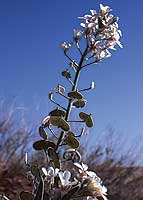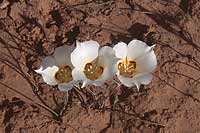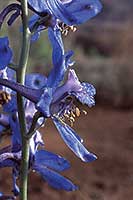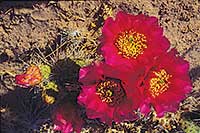 The spectacular geologic formations that define the Canyonlands Region of southeastern Utah are ever present. Hoodoos and pinnacles, natural bridges and arches, spires and buttes, canyons and mesas – these features make up this incredible landscape. Though the geologic formations and erosional remnants take center stage most of the year, during the procession of spring wildflowers these rocks are relegated to just scenic backdrop.
The spectacular geologic formations that define the Canyonlands Region of southeastern Utah are ever present. Hoodoos and pinnacles, natural bridges and arches, spires and buttes, canyons and mesas – these features make up this incredible landscape. Though the geologic formations and erosional remnants take center stage most of the year, during the procession of spring wildflowers these rocks are relegated to just scenic backdrop.
Springtime is the season of renewal here in Canyon Country. The seemingly lifeless landscape takes on a new dimension as a verdant wave rolls across the desert. This lushness is punctuated by a rainbow of color encapsulated within the petals of flowers.
Though the early portion of spring is revealed with the first flush of shrubs and wildflowers emerging from winter slumber, the month of May represents the crest of this rejuvenating wave. For following on the heels of spring is the furnace of summer that can easily negate this lushness.
 Spring may be represented by fields of wildflowers creating a patchwork of color across this land. Splashes of orange globemallows or yellow beeplants may cloak the ground where seemingly nothing should grow. Flats of sego lilies, with their insides of their creamy petals adorned with eyebrows of purple, reveal that the winter’s moisture level was sufficient to encourage all to bloom. During these moist years, vast tracts of blackbrush - a dull looking, low growing shrub for most of the year - transforms into a sea of yellow interrupted only by the spaces between plants.
Spring may be represented by fields of wildflowers creating a patchwork of color across this land. Splashes of orange globemallows or yellow beeplants may cloak the ground where seemingly nothing should grow. Flats of sego lilies, with their insides of their creamy petals adorned with eyebrows of purple, reveal that the winter’s moisture level was sufficient to encourage all to bloom. During these moist years, vast tracts of blackbrush - a dull looking, low growing shrub for most of the year - transforms into a sea of yellow interrupted only by the spaces between plants.
There are the sky-blue larkspurs, with their dolphin-shaped buds that give rise to the plant’s genus Delphinium. There are the brilliant blazing stars and lava-red Indian paintbrushes that seem to erupt from the ground. In some of the sandier dune areas one can search for spectacle-pod and lupine tucked away behind stabilized dunes colonized by sand verbenas, carnaigre and evening primroses.
That anything grows at all in this land of rock and sand is amazing in itself. But look at most of the trees, shrubs and wildflowers growing in the dry uplands and you’ll notice some common themes: tiny leaves, waxy coatings on the leaves, extensive root systems that go laterally, armed with spines and low in stature. These plants have adapted to this land of little rain, where temperatures range from below zero to above 100°F, and where an annual accumulation of rainfall over 10 inches is considered a bonanza. When the rains do come or when winter moisture soaks the ground, the plants respond with an explosion of growth and flower production.
Annual plants, those ephemeral wildflowers with a one-and-done growth habit, race through their life cycle to the seed set stage. The future survival of the species is encapsulated within the protective coat of the pin-sized seed. At times dormant for years, these seeds define the word “patient” as they await the right conditions for germination, sometimes for years.
 Perennials follow a different path, their seed set for future generations a part of their life cycle, but energy is put into maintaining the plant’s survival year after year. Woody stems and hardy roots, deciduous leaves that drop like New Year resolutions, slow growth chosen over boom-and-bust, these plants may die back each winter or grow at a tortoise’s pace.
Perennials follow a different path, their seed set for future generations a part of their life cycle, but energy is put into maintaining the plant’s survival year after year. Woody stems and hardy roots, deciduous leaves that drop like New Year resolutions, slow growth chosen over boom-and-bust, these plants may die back each winter or grow at a tortoise’s pace.
The symphonic production of spring wildflowers varies not only in their instruments of colors, but also in the habitats where they perform. From sandy dune to rocky outcrop to hidden alcove dampened by springs, these desert wildflowers don’t know they are stealing the show, but they are.

 The spectacular geologic formations that define the Canyonlands Region of southeastern Utah are ever present. Hoodoos and pinnacles, natural bridges and arches, spires and buttes, canyons and mesas – these features make up this incredible landscape. Though the geologic formations and erosional remnants take center stage most of the year, during the procession of spring wildflowers these rocks are relegated to just scenic backdrop.
The spectacular geologic formations that define the Canyonlands Region of southeastern Utah are ever present. Hoodoos and pinnacles, natural bridges and arches, spires and buttes, canyons and mesas – these features make up this incredible landscape. Though the geologic formations and erosional remnants take center stage most of the year, during the procession of spring wildflowers these rocks are relegated to just scenic backdrop. Spring may be represented by fields of wildflowers creating a patchwork of color across this land. Splashes of orange globemallows or yellow beeplants may cloak the ground where seemingly nothing should grow. Flats of sego lilies, with their insides of their creamy petals adorned with eyebrows of purple, reveal that the winter’s moisture level was sufficient to encourage all to bloom. During these moist years, vast tracts of blackbrush - a dull looking, low growing shrub for most of the year - transforms into a sea of yellow interrupted only by the spaces between plants.
Spring may be represented by fields of wildflowers creating a patchwork of color across this land. Splashes of orange globemallows or yellow beeplants may cloak the ground where seemingly nothing should grow. Flats of sego lilies, with their insides of their creamy petals adorned with eyebrows of purple, reveal that the winter’s moisture level was sufficient to encourage all to bloom. During these moist years, vast tracts of blackbrush - a dull looking, low growing shrub for most of the year - transforms into a sea of yellow interrupted only by the spaces between plants.
 Perennials follow a different path, their seed set for future generations a part of their life cycle, but energy is put into maintaining the plant’s survival year after year. Woody stems and hardy roots, deciduous leaves that drop like New Year resolutions, slow growth chosen over boom-and-bust, these plants may die back each winter or grow at a tortoise’s pace.
Perennials follow a different path, their seed set for future generations a part of their life cycle, but energy is put into maintaining the plant’s survival year after year. Woody stems and hardy roots, deciduous leaves that drop like New Year resolutions, slow growth chosen over boom-and-bust, these plants may die back each winter or grow at a tortoise’s pace.